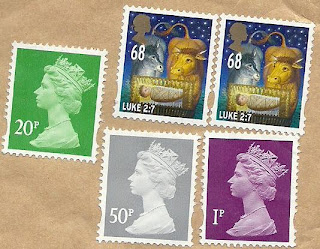
Swiss Alps Jungfrau-Aletsch.
Sent by
Katharina, a postcrosser from Switzerland.
This is from UNESCO :
The Jungfrau-Aletsch-Bietschhorn region is located in the south central Swiss Alps midway between the cities of Brig and Interlaken, 77% in Valais and 23% in Bern. Nine peaks in the site are higher than 4,000 m.
The geology of the site derives from the 'Helvetic nappe' (a large body of rock that was thrust over younger rock in Europe during the Miocene epoch). The folding and over-thrusting of rock layers during the formation of the Alps have produced very complex rock formations that have since been exposed by glacial activity. The physiography of the area is characterized by steep north-facing slopes and relatively gentle southern ones. Classic examples of glacial phenomena occur in the site, such as U-shaped valleys, valley glaciers, cirques, horn peaks and moraines.
Vegetation and fauna are representative of the Alps and vary by slope, aspect and elevation. There is a marked difference in vegetation between the northern and southern slopes. On the north side, forests at lower elevations consist of broadleaved species such as beech, ash, alder, elm and birch. The south side is too dry for beech, which is replaced by Scots pine. On the northern side, the subalpine zone is dominated by Norway spruce with mountain ash, silver birch and stone pine and, on the southern side, by more continental species such as European larch on young soils.
Above the timberline are extensive areas of rhododendron scrub, alpine grassland and tundra vegetation and, on the xeric southern slopes, steppe grassland.
Fauna in the region is typical of the Alps, with a wide variety of species including ibex, lynx, red deer, roe deer, chamois and marmot as well as several reptiles and amphibians. A representative range of alpine birds also occurs, including golden eagle, kestrel, chough, ptarmigan, black grouse, snow finch, wallcreeper, lammergeier, pygmy owl and various woodpecker species.
The Jungfrau-Aletsch-Bietschhorn stands out in having the following four qualities:
* The scenic and aesthetic appeal is one of the most dramatic in the Alps, as evidenced by the long history of international visitation. The impressive northern wall of the site with the panorama of the Eiger, Mönch and Jungfrau mountains provides a classic view of the north face of the High Alps. The only other alpine regions that rival it for sheer scenic splendour are the Pennine Alps around the Matterhorn/Monte Rosa and Mont Blanc.
* Glaciation is the most extensive in the Alps. The Aletsch is the largest and longest glacier in western Eurasia in terms of area (128km2), length (23km) and depth (900m).
* The extensive glaciation and rugged topography, as well as protection measures dating back to 1933, have resulted in this being one of the most (if not the most) undisturbed natural areas in the Alps.
* For its record of productive scientific research on geology, geomorphology, climatic change, biology and atmospheric physics, the region is unsurpassed in the Alps and, in certain fields, at the global level. Observations on some of the glaciers go back to the 12th century and have allowed reconstructions of historical fluctuations.
































